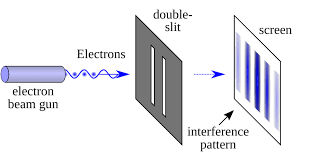
Imagine throwing marbles at a wall with two vertical gaps. You’d expect two piles of marbles behind the gaps, right? But what if instead of marbles, you used something tinier—like electrons or particles of light (photons)? This is the idea behind the double slit experiment, a famous test that reveals how particles behave in weird, wave-like ways.
The Tools:
The Prediction:
If particles act like tiny marbles, they should go through one slit or the other and create two bright lines on the screen.

When scientists fired particles (like electrons) one at a time through the slits, something strange happened. Instead of two lines, the screen showed multiple striped bands, like the pattern you see when waves interfere with each other. For example, if you toss two pebbles into a pond, their ripples overlap to create peaks and valleys. The same thing happened here—particles acted like waves!
Here’s where things get spooky. When scientists placed a detector to see which slit each particle went through, the result changed completely. The striped wave pattern vanished, and the screen showed only two lines—just like marbles.
This means:
The double slit experiment (first done with light by Thomas Young in 1801, and later with electrons) shows that at the quantum level:
This experiment is a cornerstone of quantum mechanics, the science that explains how tiny particles like atoms and photons work. It challenges our everyday intuition about how the world “should” behave.
While the experiment itself is abstract, its principles power modern technologies: